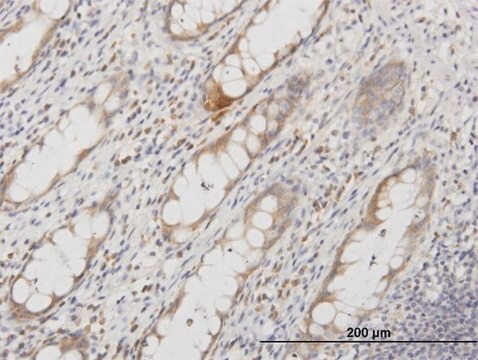A6011
Acetazolamide
≥99%, powder
Synonym(s):
5-Acetamido-1,3,4-thiadiazole-2-sulfonamide, N-(5-Sulfamoyl-1,3,4-thiadiazol-2-yl)acetamide, N-(5-[Aminosulfonyl]-1,3,4-thiadiazol-2-yl)acetamide
About This Item
Recommended Products
biological source
synthetic
Assay
≥99%
form
powder
pKa
7.2
mp
258-259 °C
solubility
1 M NH4OH: 50 mg/mL
DMSO: soluble
methanol and ethanol: slightly soluble
SMILES string
CC(=O)Nc1nnc(s1)S(N)(=O)=O
InChI
1S/C4H6N4O3S2/c1-2(9)6-3-7-8-4(12-3)13(5,10)11/h1H3,(H2,5,10,11)(H,6,7,9)
InChI key
BZKPWHYZMXOIDC-UHFFFAOYSA-N
Gene Information
human ... CA1(759) , CA12(771) , CA14(23632) , CA2(760) , CA3(761) , CA4(762) , CA5A(763) , CA5B(11238) , CA9(768)
mouse ... Car13(71934) , Car5a(12352)
rat ... Car2(54231) , Car4(29242)
Looking for similar products? Visit Product Comparison Guide
Application
- to study its protective effect on steatotic liver grafts against cold ischemia reperfusion injury{49)
- to determine its ability to bind isolated porcine retinal pigment epithelium (RPE) melanin by cassette dosing and rapid equilibrium dialysis inserts
- to validate the in vitro gastrulation model of P19C5 stem cells for developmental toxicity screening assays
- to study its inhibitory effect on melanogenesis through enzyme kinetic, in vitro, in vivo and in silico analyses in zebrafish and in A375 human melanoma cells
Biochem/physiol Actions
Signal Word
Warning
Hazard Statements
Precautionary Statements
Hazard Classifications
Eye Irrit. 2 - Skin Irrit. 2
Storage Class Code
11 - Combustible Solids
WGK
WGK 3
Flash Point(F)
Not applicable
Flash Point(C)
Not applicable
Personal Protective Equipment
Certificates of Analysis (COA)
Search for Certificates of Analysis (COA) by entering the products Lot/Batch Number. Lot and Batch Numbers can be found on a product’s label following the words ‘Lot’ or ‘Batch’.
Already Own This Product?
Find documentation for the products that you have recently purchased in the Document Library.
Customers Also Viewed
Our team of scientists has experience in all areas of research including Life Science, Material Science, Chemical Synthesis, Chromatography, Analytical and many others.
Contact Technical Service










